PepsiCo: Marketing Research and Buying Decision Analysis Report
VerifiedAdded on 2020/02/03
|15
|3111
|578
Report
AI Summary
This report provides a comprehensive analysis of PepsiCo's marketing strategies, focusing on the buying decision-making process and market research techniques. It examines the key stages of consumer purchase decisions, including problem recognition, information search, and post-purchase behavior, within the context of PepsiCo's operations. The report explores factors influencing buying behavior, such as cultural, social, personal, and psychological aspects, alongside the importance of brand loyalty, corporate image, and repeat purchasing. It also outlines market research objectives, techniques (qualitative and quantitative), and data sources, discussing validity and reliability. Furthermore, the report conducts a competitive analysis using Porter's Five Forces, SWOT analysis, and assesses PepsiCo's market size and key competitors. Finally, it investigates techniques for assessing customer response, including customer satisfaction surveys, and evaluates their effectiveness.
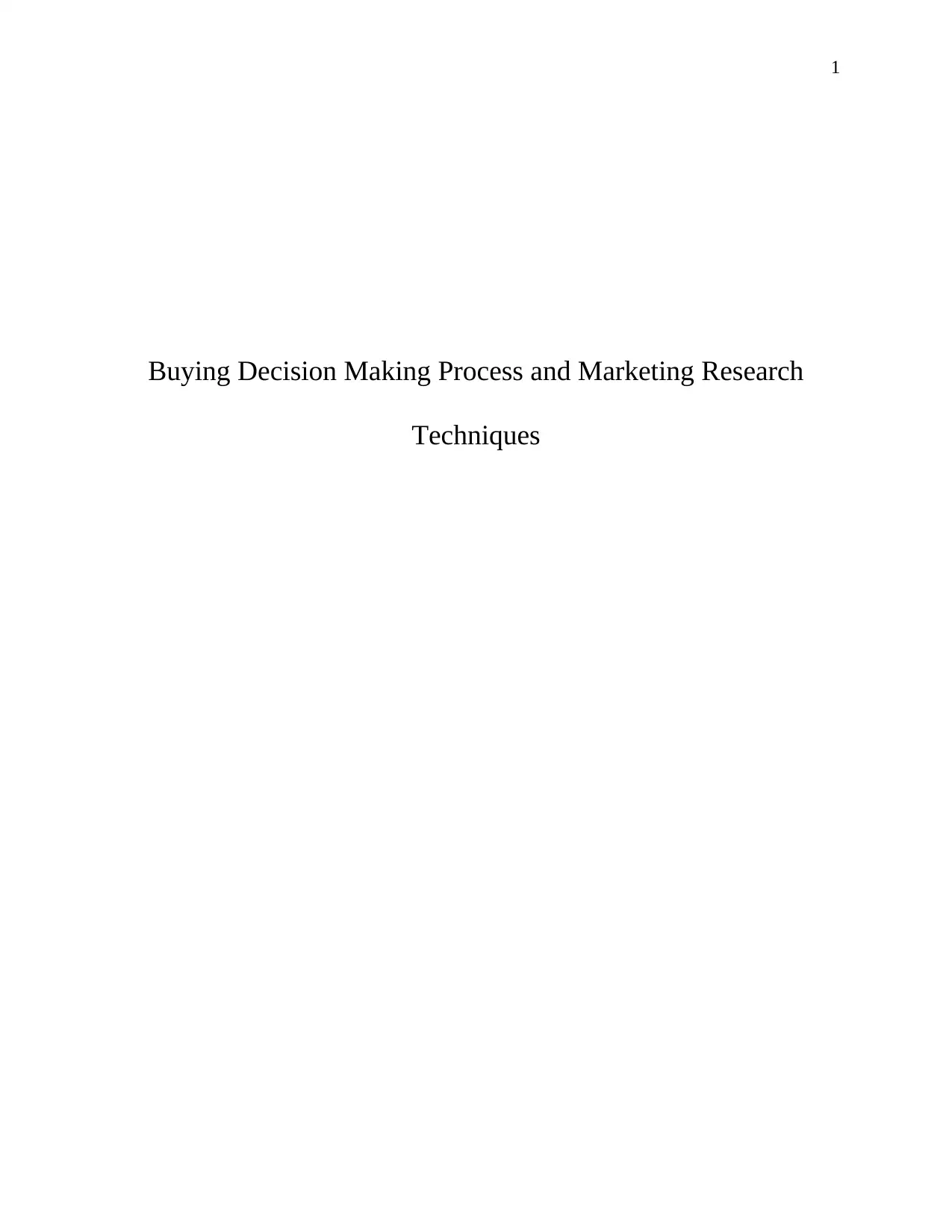
1
Buying Decision Making Process and Marketing Research
Techniques
Buying Decision Making Process and Marketing Research
Techniques
Paraphrase This Document
Need a fresh take? Get an instant paraphrase of this document with our AI Paraphraser
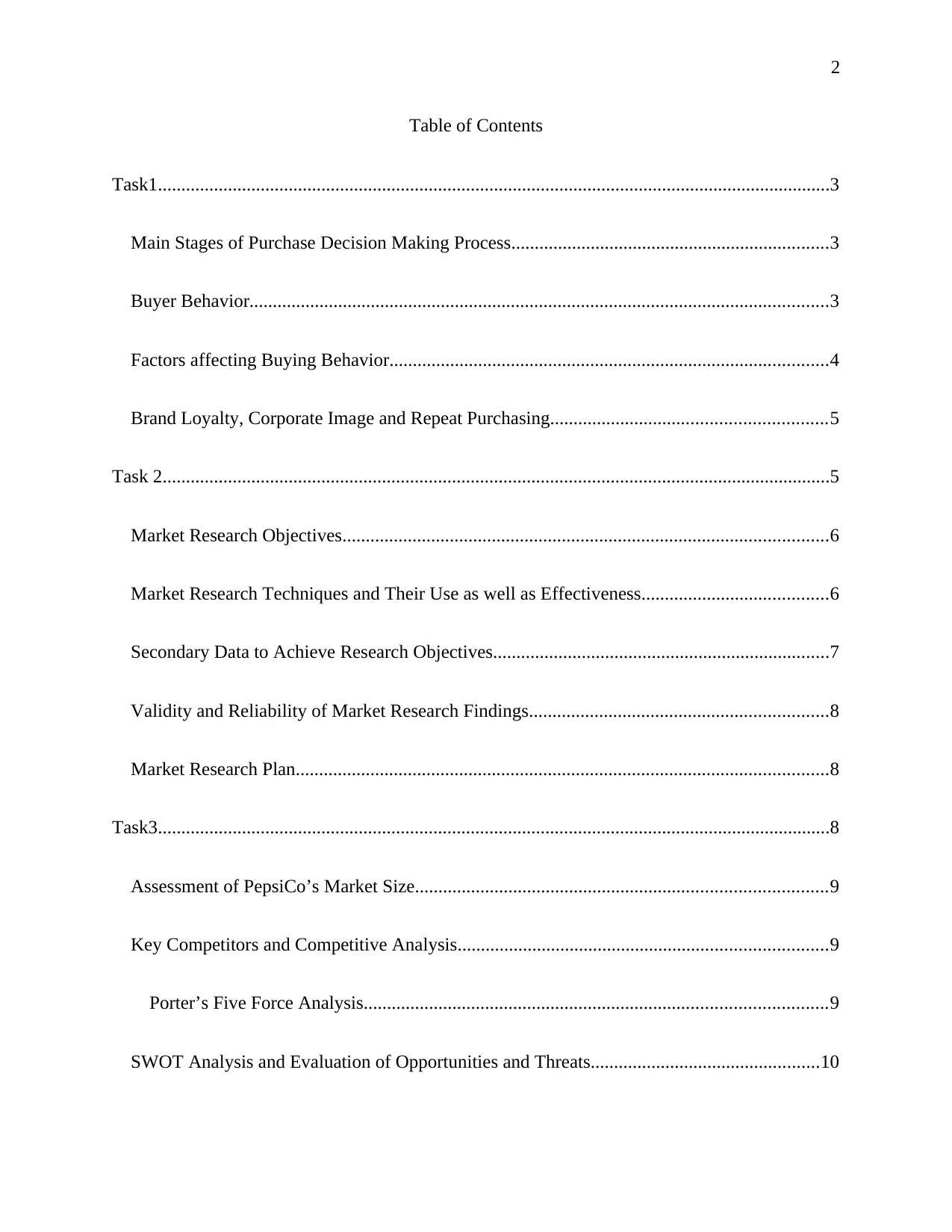
2
Table of Contents
Task1................................................................................................................................................3
Main Stages of Purchase Decision Making Process....................................................................3
Buyer Behavior............................................................................................................................3
Factors affecting Buying Behavior..............................................................................................4
Brand Loyalty, Corporate Image and Repeat Purchasing...........................................................5
Task 2...............................................................................................................................................5
Market Research Objectives........................................................................................................6
Market Research Techniques and Their Use as well as Effectiveness........................................6
Secondary Data to Achieve Research Objectives........................................................................7
Validity and Reliability of Market Research Findings................................................................8
Market Research Plan..................................................................................................................8
Task3................................................................................................................................................8
Assessment of PepsiCo’s Market Size........................................................................................9
Key Competitors and Competitive Analysis...............................................................................9
Porter’s Five Force Analysis...................................................................................................9
SWOT Analysis and Evaluation of Opportunities and Threats.................................................10
Table of Contents
Task1................................................................................................................................................3
Main Stages of Purchase Decision Making Process....................................................................3
Buyer Behavior............................................................................................................................3
Factors affecting Buying Behavior..............................................................................................4
Brand Loyalty, Corporate Image and Repeat Purchasing...........................................................5
Task 2...............................................................................................................................................5
Market Research Objectives........................................................................................................6
Market Research Techniques and Their Use as well as Effectiveness........................................6
Secondary Data to Achieve Research Objectives........................................................................7
Validity and Reliability of Market Research Findings................................................................8
Market Research Plan..................................................................................................................8
Task3................................................................................................................................................8
Assessment of PepsiCo’s Market Size........................................................................................9
Key Competitors and Competitive Analysis...............................................................................9
Porter’s Five Force Analysis...................................................................................................9
SWOT Analysis and Evaluation of Opportunities and Threats.................................................10
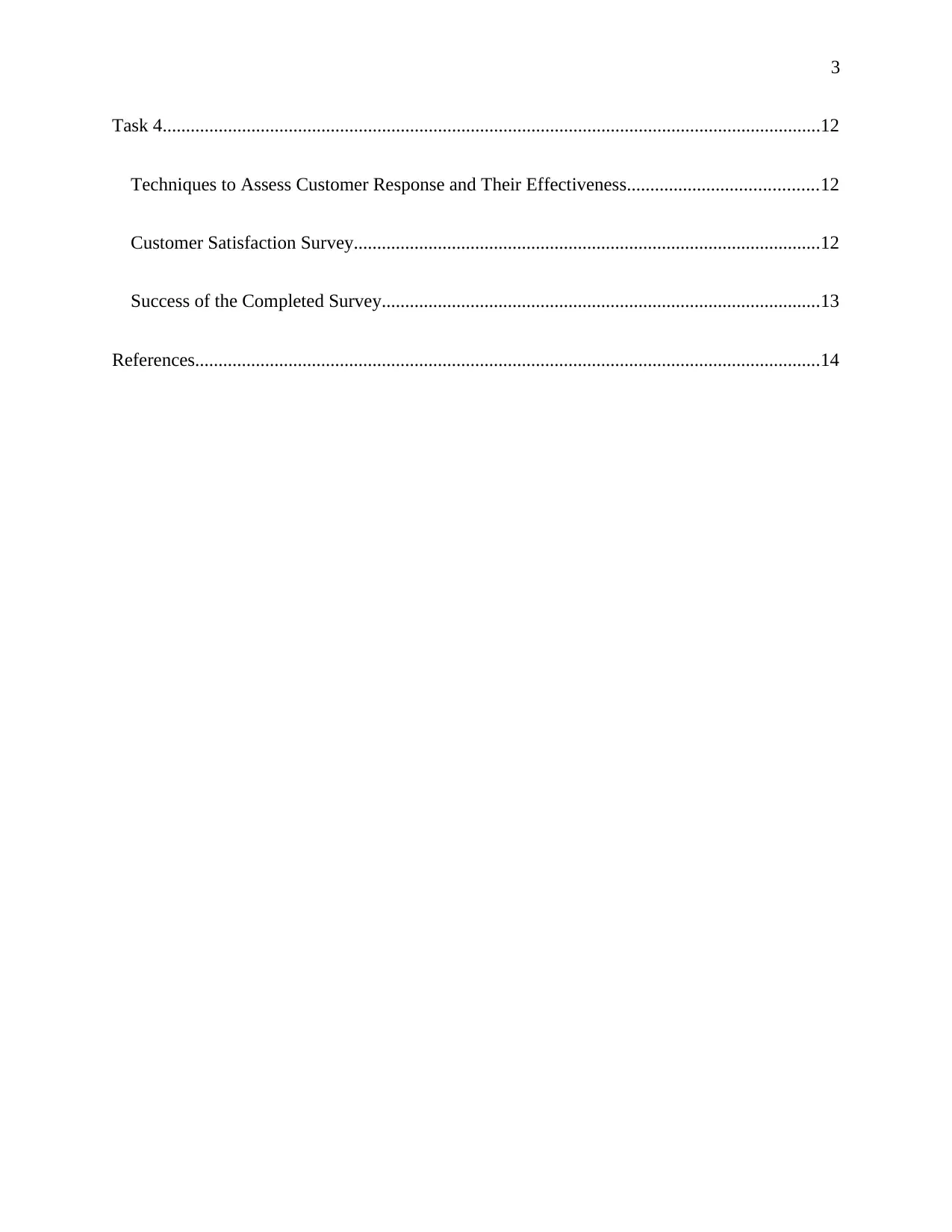
3
Task 4.............................................................................................................................................12
Techniques to Assess Customer Response and Their Effectiveness.........................................12
Customer Satisfaction Survey....................................................................................................12
Success of the Completed Survey..............................................................................................13
References......................................................................................................................................14
Task 4.............................................................................................................................................12
Techniques to Assess Customer Response and Their Effectiveness.........................................12
Customer Satisfaction Survey....................................................................................................12
Success of the Completed Survey..............................................................................................13
References......................................................................................................................................14
⊘ This is a preview!⊘
Do you want full access?
Subscribe today to unlock all pages.

Trusted by 1+ million students worldwide
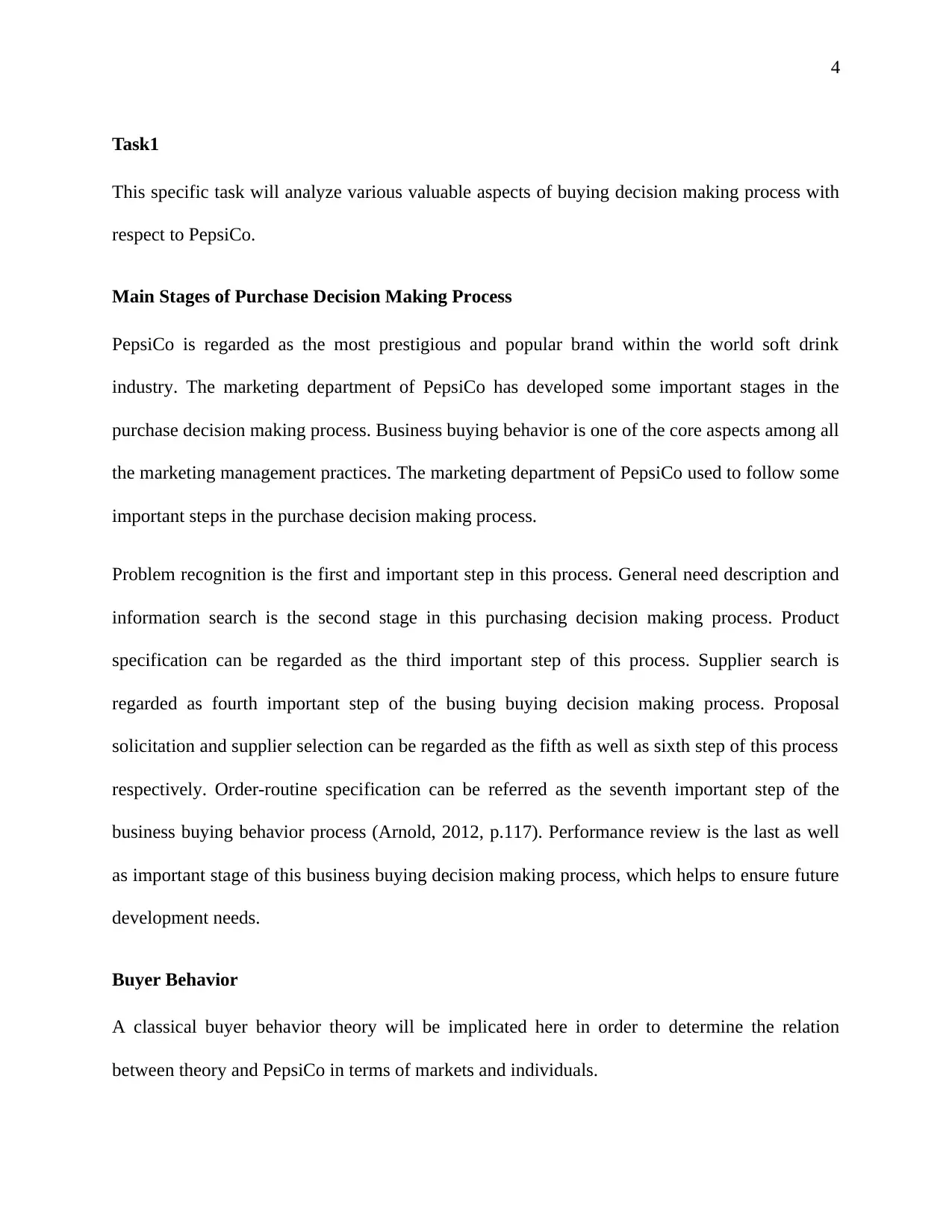
4
Task1
This specific task will analyze various valuable aspects of buying decision making process with
respect to PepsiCo.
Main Stages of Purchase Decision Making Process
PepsiCo is regarded as the most prestigious and popular brand within the world soft drink
industry. The marketing department of PepsiCo has developed some important stages in the
purchase decision making process. Business buying behavior is one of the core aspects among all
the marketing management practices. The marketing department of PepsiCo used to follow some
important steps in the purchase decision making process.
Problem recognition is the first and important step in this process. General need description and
information search is the second stage in this purchasing decision making process. Product
specification can be regarded as the third important step of this process. Supplier search is
regarded as fourth important step of the busing buying decision making process. Proposal
solicitation and supplier selection can be regarded as the fifth as well as sixth step of this process
respectively. Order-routine specification can be referred as the seventh important step of the
business buying behavior process (Arnold, 2012, p.117). Performance review is the last as well
as important stage of this business buying decision making process, which helps to ensure future
development needs.
Buyer Behavior
A classical buyer behavior theory will be implicated here in order to determine the relation
between theory and PepsiCo in terms of markets and individuals.
Task1
This specific task will analyze various valuable aspects of buying decision making process with
respect to PepsiCo.
Main Stages of Purchase Decision Making Process
PepsiCo is regarded as the most prestigious and popular brand within the world soft drink
industry. The marketing department of PepsiCo has developed some important stages in the
purchase decision making process. Business buying behavior is one of the core aspects among all
the marketing management practices. The marketing department of PepsiCo used to follow some
important steps in the purchase decision making process.
Problem recognition is the first and important step in this process. General need description and
information search is the second stage in this purchasing decision making process. Product
specification can be regarded as the third important step of this process. Supplier search is
regarded as fourth important step of the busing buying decision making process. Proposal
solicitation and supplier selection can be regarded as the fifth as well as sixth step of this process
respectively. Order-routine specification can be referred as the seventh important step of the
business buying behavior process (Arnold, 2012, p.117). Performance review is the last as well
as important stage of this business buying decision making process, which helps to ensure future
development needs.
Buyer Behavior
A classical buyer behavior theory will be implicated here in order to determine the relation
between theory and PepsiCo in terms of markets and individuals.
Paraphrase This Document
Need a fresh take? Get an instant paraphrase of this document with our AI Paraphraser

5
There are five important elements of the classical buying behavior theory, such as problem
recognition, information search, evaluation of alternatives, purchase decision, and post purchase
behavior. In this particular theoretical approach, the marketing department generally identifies
issue regarding the differences between present and desired situation. In this stage, the
individuals used to perceive something about the quality or any feature of the product or service.
In information search stage, the marketing department of PepsiCo utilizes advertising activities
for customers and other stakeholders. In this process, the consumers can identify the quality or
any important aspect regarding brand of the product through the advertising activities.
Evaluation of alternatives is the third important stage of this purchasing decision model. In this
model the consumers used to compare the quality and other features of the products of PepsiCo
with the products of other brands (belch and Michael, 2015, p.692). Purchase is regarded as the
fourth important step of this classical model, in which the target customers used to decide the
purchasing of the products of PepsiCo based on perception regarding quality, price, quantity,
brand image and product features. Post purchase evaluation can be regarded as the most
important step in the classical decision making process. The management of PepsiCo is highly
responsible for the successful completion of this stage. In this stage, the marketing or sales
department of PepsiCo used to judge the level of customer satisfaction through the parameter of
satisfaction or dissatisfaction regarding performance, durability, and transaction and cognitive
dissonance activities. Hence, it can be stated that the marketing department of PepsiCo used to
develop strategies based on the purchasing decision making parameters.
Factors affecting Buying Behavior
There are several important factors, which may affect the purchasing decision making process of
the buyers. Most important four types of important factors actually affect the consumer buying
There are five important elements of the classical buying behavior theory, such as problem
recognition, information search, evaluation of alternatives, purchase decision, and post purchase
behavior. In this particular theoretical approach, the marketing department generally identifies
issue regarding the differences between present and desired situation. In this stage, the
individuals used to perceive something about the quality or any feature of the product or service.
In information search stage, the marketing department of PepsiCo utilizes advertising activities
for customers and other stakeholders. In this process, the consumers can identify the quality or
any important aspect regarding brand of the product through the advertising activities.
Evaluation of alternatives is the third important stage of this purchasing decision model. In this
model the consumers used to compare the quality and other features of the products of PepsiCo
with the products of other brands (belch and Michael, 2015, p.692). Purchase is regarded as the
fourth important step of this classical model, in which the target customers used to decide the
purchasing of the products of PepsiCo based on perception regarding quality, price, quantity,
brand image and product features. Post purchase evaluation can be regarded as the most
important step in the classical decision making process. The management of PepsiCo is highly
responsible for the successful completion of this stage. In this stage, the marketing or sales
department of PepsiCo used to judge the level of customer satisfaction through the parameter of
satisfaction or dissatisfaction regarding performance, durability, and transaction and cognitive
dissonance activities. Hence, it can be stated that the marketing department of PepsiCo used to
develop strategies based on the purchasing decision making parameters.
Factors affecting Buying Behavior
There are several important factors, which may affect the purchasing decision making process of
the buyers. Most important four types of important factors actually affect the consumer buying
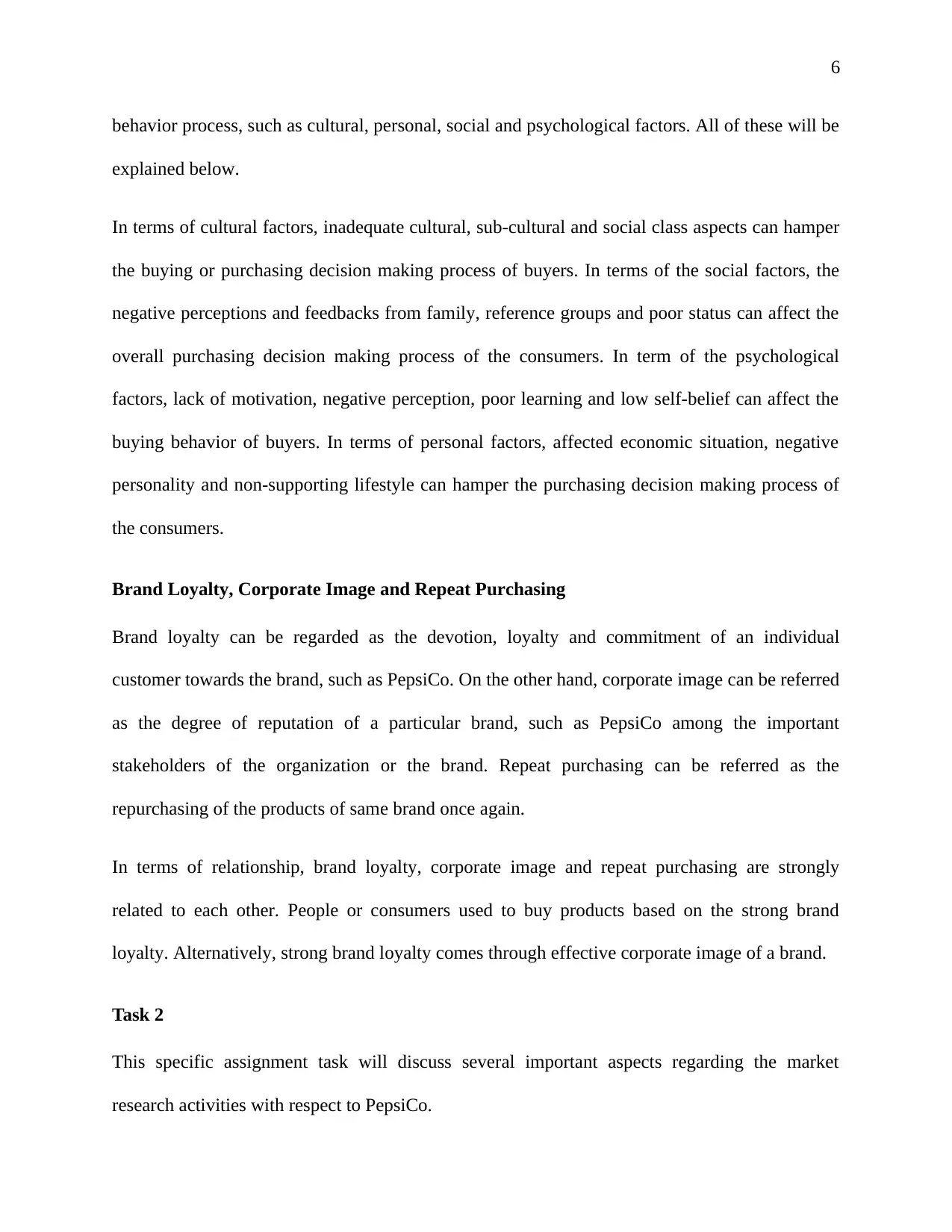
6
behavior process, such as cultural, personal, social and psychological factors. All of these will be
explained below.
In terms of cultural factors, inadequate cultural, sub-cultural and social class aspects can hamper
the buying or purchasing decision making process of buyers. In terms of the social factors, the
negative perceptions and feedbacks from family, reference groups and poor status can affect the
overall purchasing decision making process of the consumers. In term of the psychological
factors, lack of motivation, negative perception, poor learning and low self-belief can affect the
buying behavior of buyers. In terms of personal factors, affected economic situation, negative
personality and non-supporting lifestyle can hamper the purchasing decision making process of
the consumers.
Brand Loyalty, Corporate Image and Repeat Purchasing
Brand loyalty can be regarded as the devotion, loyalty and commitment of an individual
customer towards the brand, such as PepsiCo. On the other hand, corporate image can be referred
as the degree of reputation of a particular brand, such as PepsiCo among the important
stakeholders of the organization or the brand. Repeat purchasing can be referred as the
repurchasing of the products of same brand once again.
In terms of relationship, brand loyalty, corporate image and repeat purchasing are strongly
related to each other. People or consumers used to buy products based on the strong brand
loyalty. Alternatively, strong brand loyalty comes through effective corporate image of a brand.
Task 2
This specific assignment task will discuss several important aspects regarding the market
research activities with respect to PepsiCo.
behavior process, such as cultural, personal, social and psychological factors. All of these will be
explained below.
In terms of cultural factors, inadequate cultural, sub-cultural and social class aspects can hamper
the buying or purchasing decision making process of buyers. In terms of the social factors, the
negative perceptions and feedbacks from family, reference groups and poor status can affect the
overall purchasing decision making process of the consumers. In term of the psychological
factors, lack of motivation, negative perception, poor learning and low self-belief can affect the
buying behavior of buyers. In terms of personal factors, affected economic situation, negative
personality and non-supporting lifestyle can hamper the purchasing decision making process of
the consumers.
Brand Loyalty, Corporate Image and Repeat Purchasing
Brand loyalty can be regarded as the devotion, loyalty and commitment of an individual
customer towards the brand, such as PepsiCo. On the other hand, corporate image can be referred
as the degree of reputation of a particular brand, such as PepsiCo among the important
stakeholders of the organization or the brand. Repeat purchasing can be referred as the
repurchasing of the products of same brand once again.
In terms of relationship, brand loyalty, corporate image and repeat purchasing are strongly
related to each other. People or consumers used to buy products based on the strong brand
loyalty. Alternatively, strong brand loyalty comes through effective corporate image of a brand.
Task 2
This specific assignment task will discuss several important aspects regarding the market
research activities with respect to PepsiCo.
⊘ This is a preview!⊘
Do you want full access?
Subscribe today to unlock all pages.

Trusted by 1+ million students worldwide
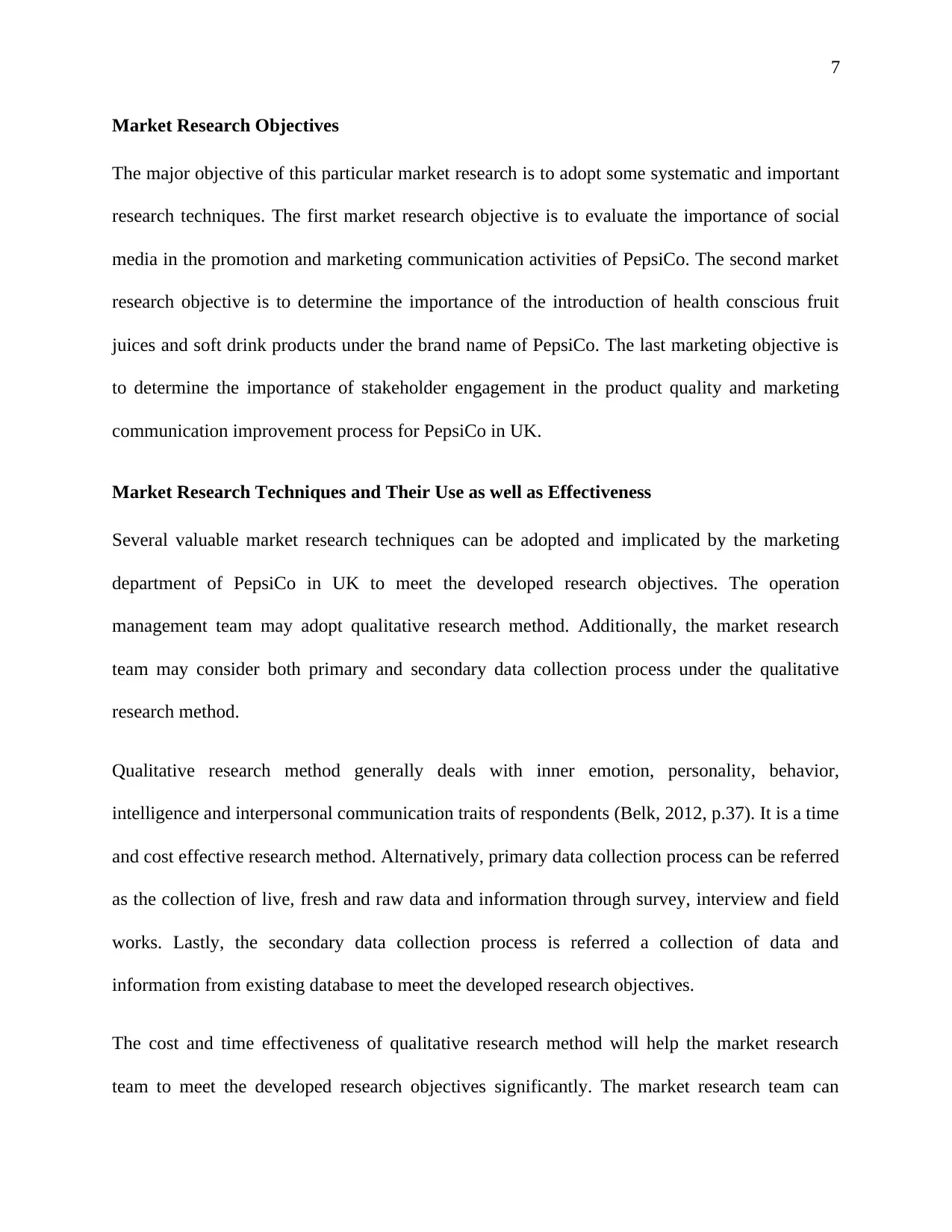
7
Market Research Objectives
The major objective of this particular market research is to adopt some systematic and important
research techniques. The first market research objective is to evaluate the importance of social
media in the promotion and marketing communication activities of PepsiCo. The second market
research objective is to determine the importance of the introduction of health conscious fruit
juices and soft drink products under the brand name of PepsiCo. The last marketing objective is
to determine the importance of stakeholder engagement in the product quality and marketing
communication improvement process for PepsiCo in UK.
Market Research Techniques and Their Use as well as Effectiveness
Several valuable market research techniques can be adopted and implicated by the marketing
department of PepsiCo in UK to meet the developed research objectives. The operation
management team may adopt qualitative research method. Additionally, the market research
team may consider both primary and secondary data collection process under the qualitative
research method.
Qualitative research method generally deals with inner emotion, personality, behavior,
intelligence and interpersonal communication traits of respondents (Belk, 2012, p.37). It is a time
and cost effective research method. Alternatively, primary data collection process can be referred
as the collection of live, fresh and raw data and information through survey, interview and field
works. Lastly, the secondary data collection process is referred a collection of data and
information from existing database to meet the developed research objectives.
The cost and time effectiveness of qualitative research method will help the market research
team to meet the developed research objectives significantly. The market research team can
Market Research Objectives
The major objective of this particular market research is to adopt some systematic and important
research techniques. The first market research objective is to evaluate the importance of social
media in the promotion and marketing communication activities of PepsiCo. The second market
research objective is to determine the importance of the introduction of health conscious fruit
juices and soft drink products under the brand name of PepsiCo. The last marketing objective is
to determine the importance of stakeholder engagement in the product quality and marketing
communication improvement process for PepsiCo in UK.
Market Research Techniques and Their Use as well as Effectiveness
Several valuable market research techniques can be adopted and implicated by the marketing
department of PepsiCo in UK to meet the developed research objectives. The operation
management team may adopt qualitative research method. Additionally, the market research
team may consider both primary and secondary data collection process under the qualitative
research method.
Qualitative research method generally deals with inner emotion, personality, behavior,
intelligence and interpersonal communication traits of respondents (Belk, 2012, p.37). It is a time
and cost effective research method. Alternatively, primary data collection process can be referred
as the collection of live, fresh and raw data and information through survey, interview and field
works. Lastly, the secondary data collection process is referred a collection of data and
information from existing database to meet the developed research objectives.
The cost and time effectiveness of qualitative research method will help the market research
team to meet the developed research objectives significantly. The market research team can
Paraphrase This Document
Need a fresh take? Get an instant paraphrase of this document with our AI Paraphraser
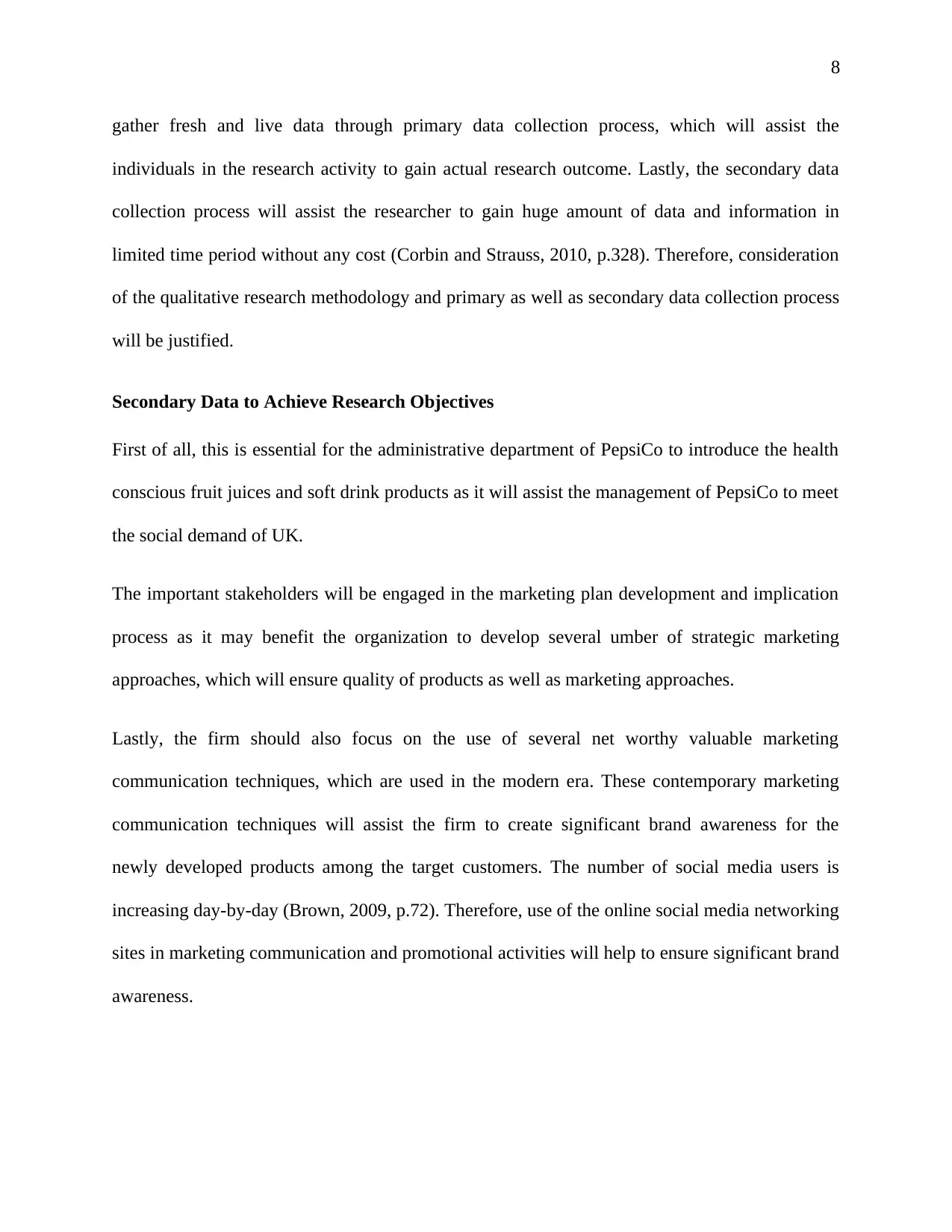
8
gather fresh and live data through primary data collection process, which will assist the
individuals in the research activity to gain actual research outcome. Lastly, the secondary data
collection process will assist the researcher to gain huge amount of data and information in
limited time period without any cost (Corbin and Strauss, 2010, p.328). Therefore, consideration
of the qualitative research methodology and primary as well as secondary data collection process
will be justified.
Secondary Data to Achieve Research Objectives
First of all, this is essential for the administrative department of PepsiCo to introduce the health
conscious fruit juices and soft drink products as it will assist the management of PepsiCo to meet
the social demand of UK.
The important stakeholders will be engaged in the marketing plan development and implication
process as it may benefit the organization to develop several umber of strategic marketing
approaches, which will ensure quality of products as well as marketing approaches.
Lastly, the firm should also focus on the use of several net worthy valuable marketing
communication techniques, which are used in the modern era. These contemporary marketing
communication techniques will assist the firm to create significant brand awareness for the
newly developed products among the target customers. The number of social media users is
increasing day-by-day (Brown, 2009, p.72). Therefore, use of the online social media networking
sites in marketing communication and promotional activities will help to ensure significant brand
awareness.
gather fresh and live data through primary data collection process, which will assist the
individuals in the research activity to gain actual research outcome. Lastly, the secondary data
collection process will assist the researcher to gain huge amount of data and information in
limited time period without any cost (Corbin and Strauss, 2010, p.328). Therefore, consideration
of the qualitative research methodology and primary as well as secondary data collection process
will be justified.
Secondary Data to Achieve Research Objectives
First of all, this is essential for the administrative department of PepsiCo to introduce the health
conscious fruit juices and soft drink products as it will assist the management of PepsiCo to meet
the social demand of UK.
The important stakeholders will be engaged in the marketing plan development and implication
process as it may benefit the organization to develop several umber of strategic marketing
approaches, which will ensure quality of products as well as marketing approaches.
Lastly, the firm should also focus on the use of several net worthy valuable marketing
communication techniques, which are used in the modern era. These contemporary marketing
communication techniques will assist the firm to create significant brand awareness for the
newly developed products among the target customers. The number of social media users is
increasing day-by-day (Brown, 2009, p.72). Therefore, use of the online social media networking
sites in marketing communication and promotional activities will help to ensure significant brand
awareness.
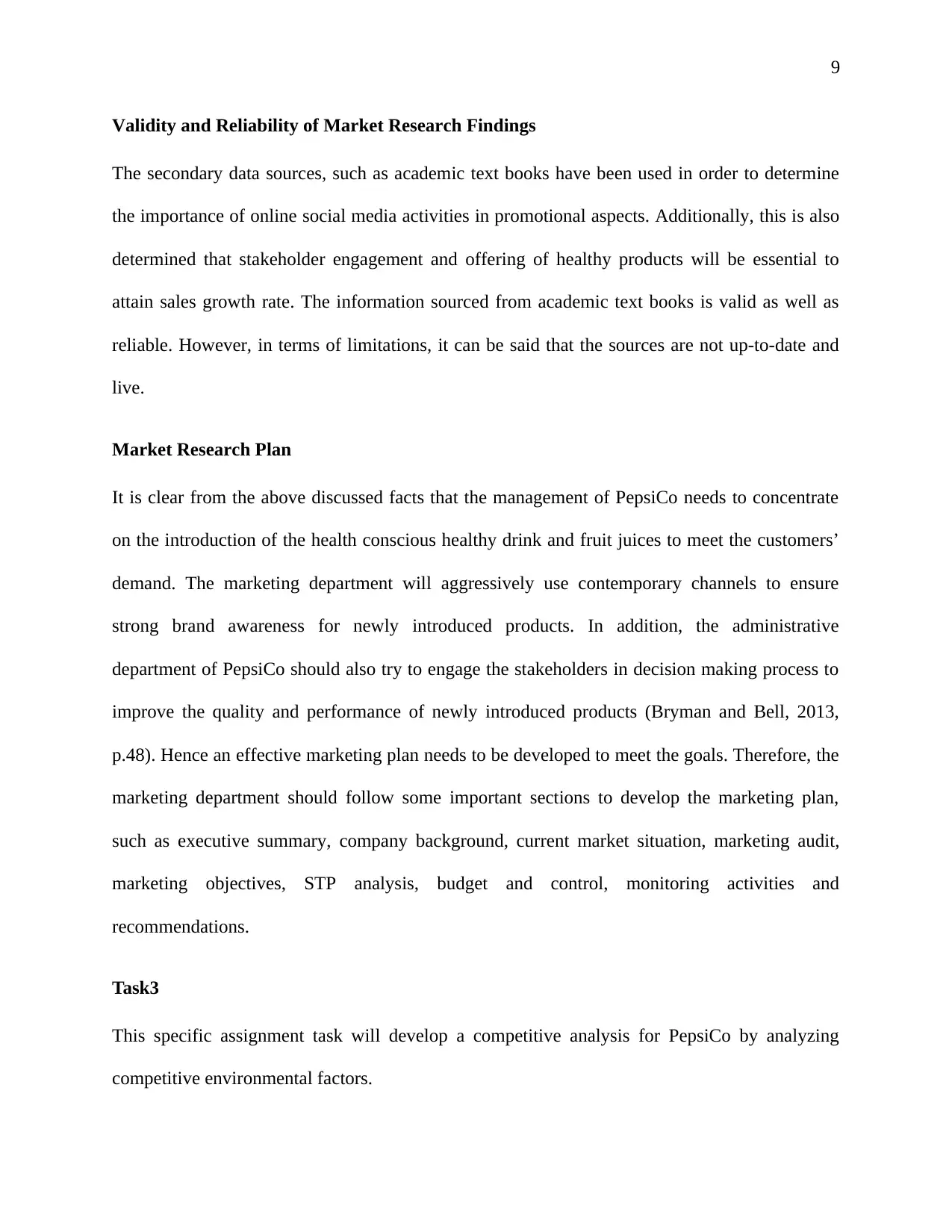
9
Validity and Reliability of Market Research Findings
The secondary data sources, such as academic text books have been used in order to determine
the importance of online social media activities in promotional aspects. Additionally, this is also
determined that stakeholder engagement and offering of healthy products will be essential to
attain sales growth rate. The information sourced from academic text books is valid as well as
reliable. However, in terms of limitations, it can be said that the sources are not up-to-date and
live.
Market Research Plan
It is clear from the above discussed facts that the management of PepsiCo needs to concentrate
on the introduction of the health conscious healthy drink and fruit juices to meet the customers’
demand. The marketing department will aggressively use contemporary channels to ensure
strong brand awareness for newly introduced products. In addition, the administrative
department of PepsiCo should also try to engage the stakeholders in decision making process to
improve the quality and performance of newly introduced products (Bryman and Bell, 2013,
p.48). Hence an effective marketing plan needs to be developed to meet the goals. Therefore, the
marketing department should follow some important sections to develop the marketing plan,
such as executive summary, company background, current market situation, marketing audit,
marketing objectives, STP analysis, budget and control, monitoring activities and
recommendations.
Task3
This specific assignment task will develop a competitive analysis for PepsiCo by analyzing
competitive environmental factors.
Validity and Reliability of Market Research Findings
The secondary data sources, such as academic text books have been used in order to determine
the importance of online social media activities in promotional aspects. Additionally, this is also
determined that stakeholder engagement and offering of healthy products will be essential to
attain sales growth rate. The information sourced from academic text books is valid as well as
reliable. However, in terms of limitations, it can be said that the sources are not up-to-date and
live.
Market Research Plan
It is clear from the above discussed facts that the management of PepsiCo needs to concentrate
on the introduction of the health conscious healthy drink and fruit juices to meet the customers’
demand. The marketing department will aggressively use contemporary channels to ensure
strong brand awareness for newly introduced products. In addition, the administrative
department of PepsiCo should also try to engage the stakeholders in decision making process to
improve the quality and performance of newly introduced products (Bryman and Bell, 2013,
p.48). Hence an effective marketing plan needs to be developed to meet the goals. Therefore, the
marketing department should follow some important sections to develop the marketing plan,
such as executive summary, company background, current market situation, marketing audit,
marketing objectives, STP analysis, budget and control, monitoring activities and
recommendations.
Task3
This specific assignment task will develop a competitive analysis for PepsiCo by analyzing
competitive environmental factors.
⊘ This is a preview!⊘
Do you want full access?
Subscribe today to unlock all pages.

Trusted by 1+ million students worldwide
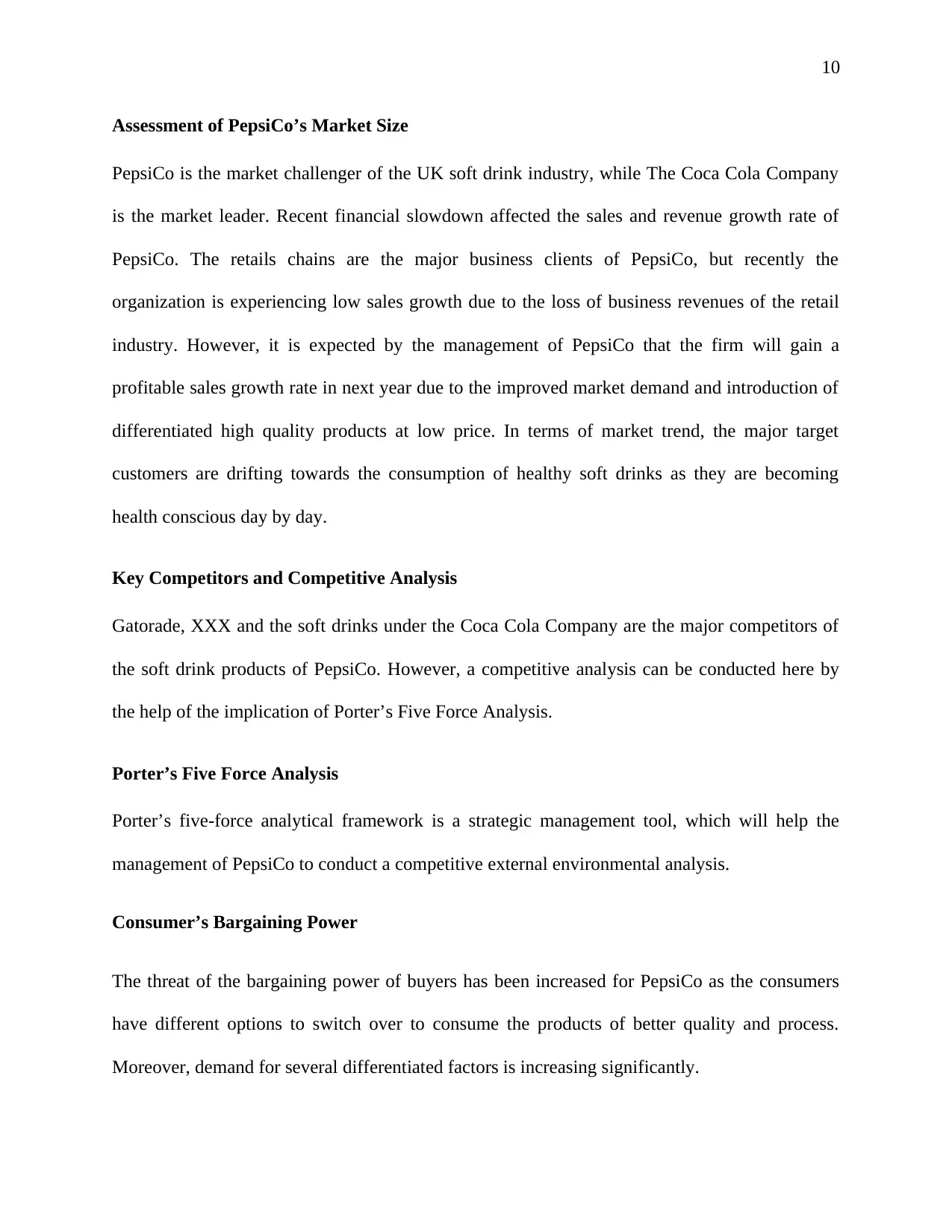
10
Assessment of PepsiCo’s Market Size
PepsiCo is the market challenger of the UK soft drink industry, while The Coca Cola Company
is the market leader. Recent financial slowdown affected the sales and revenue growth rate of
PepsiCo. The retails chains are the major business clients of PepsiCo, but recently the
organization is experiencing low sales growth due to the loss of business revenues of the retail
industry. However, it is expected by the management of PepsiCo that the firm will gain a
profitable sales growth rate in next year due to the improved market demand and introduction of
differentiated high quality products at low price. In terms of market trend, the major target
customers are drifting towards the consumption of healthy soft drinks as they are becoming
health conscious day by day.
Key Competitors and Competitive Analysis
Gatorade, XXX and the soft drinks under the Coca Cola Company are the major competitors of
the soft drink products of PepsiCo. However, a competitive analysis can be conducted here by
the help of the implication of Porter’s Five Force Analysis.
Porter’s Five Force Analysis
Porter’s five-force analytical framework is a strategic management tool, which will help the
management of PepsiCo to conduct a competitive external environmental analysis.
Consumer’s Bargaining Power
The threat of the bargaining power of buyers has been increased for PepsiCo as the consumers
have different options to switch over to consume the products of better quality and process.
Moreover, demand for several differentiated factors is increasing significantly.
Assessment of PepsiCo’s Market Size
PepsiCo is the market challenger of the UK soft drink industry, while The Coca Cola Company
is the market leader. Recent financial slowdown affected the sales and revenue growth rate of
PepsiCo. The retails chains are the major business clients of PepsiCo, but recently the
organization is experiencing low sales growth due to the loss of business revenues of the retail
industry. However, it is expected by the management of PepsiCo that the firm will gain a
profitable sales growth rate in next year due to the improved market demand and introduction of
differentiated high quality products at low price. In terms of market trend, the major target
customers are drifting towards the consumption of healthy soft drinks as they are becoming
health conscious day by day.
Key Competitors and Competitive Analysis
Gatorade, XXX and the soft drinks under the Coca Cola Company are the major competitors of
the soft drink products of PepsiCo. However, a competitive analysis can be conducted here by
the help of the implication of Porter’s Five Force Analysis.
Porter’s Five Force Analysis
Porter’s five-force analytical framework is a strategic management tool, which will help the
management of PepsiCo to conduct a competitive external environmental analysis.
Consumer’s Bargaining Power
The threat of the bargaining power of buyers has been increased for PepsiCo as the consumers
have different options to switch over to consume the products of better quality and process.
Moreover, demand for several differentiated factors is increasing significantly.
Paraphrase This Document
Need a fresh take? Get an instant paraphrase of this document with our AI Paraphraser
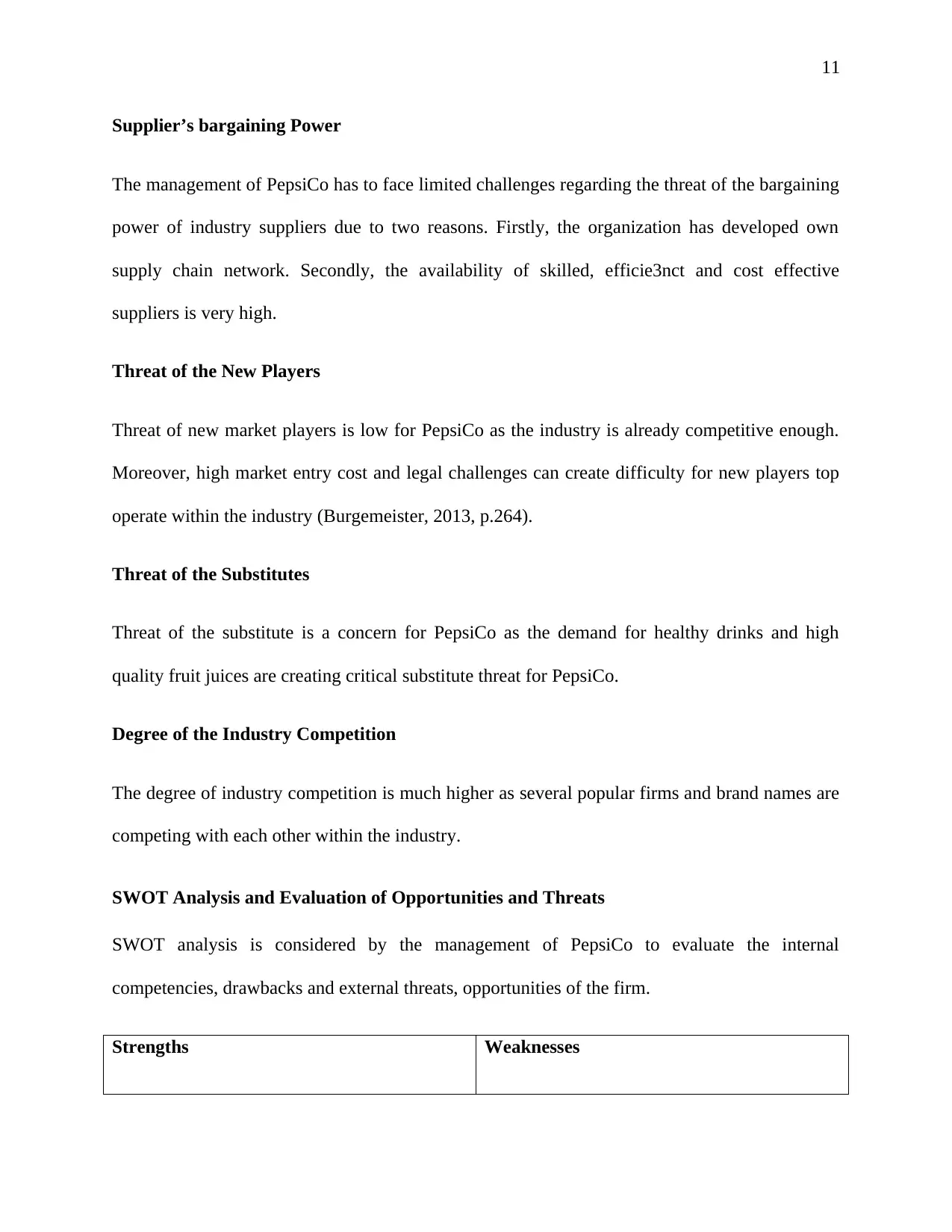
11
Supplier’s bargaining Power
The management of PepsiCo has to face limited challenges regarding the threat of the bargaining
power of industry suppliers due to two reasons. Firstly, the organization has developed own
supply chain network. Secondly, the availability of skilled, efficie3nct and cost effective
suppliers is very high.
Threat of the New Players
Threat of new market players is low for PepsiCo as the industry is already competitive enough.
Moreover, high market entry cost and legal challenges can create difficulty for new players top
operate within the industry (Burgemeister, 2013, p.264).
Threat of the Substitutes
Threat of the substitute is a concern for PepsiCo as the demand for healthy drinks and high
quality fruit juices are creating critical substitute threat for PepsiCo.
Degree of the Industry Competition
The degree of industry competition is much higher as several popular firms and brand names are
competing with each other within the industry.
SWOT Analysis and Evaluation of Opportunities and Threats
SWOT analysis is considered by the management of PepsiCo to evaluate the internal
competencies, drawbacks and external threats, opportunities of the firm.
Strengths Weaknesses
Supplier’s bargaining Power
The management of PepsiCo has to face limited challenges regarding the threat of the bargaining
power of industry suppliers due to two reasons. Firstly, the organization has developed own
supply chain network. Secondly, the availability of skilled, efficie3nct and cost effective
suppliers is very high.
Threat of the New Players
Threat of new market players is low for PepsiCo as the industry is already competitive enough.
Moreover, high market entry cost and legal challenges can create difficulty for new players top
operate within the industry (Burgemeister, 2013, p.264).
Threat of the Substitutes
Threat of the substitute is a concern for PepsiCo as the demand for healthy drinks and high
quality fruit juices are creating critical substitute threat for PepsiCo.
Degree of the Industry Competition
The degree of industry competition is much higher as several popular firms and brand names are
competing with each other within the industry.
SWOT Analysis and Evaluation of Opportunities and Threats
SWOT analysis is considered by the management of PepsiCo to evaluate the internal
competencies, drawbacks and external threats, opportunities of the firm.
Strengths Weaknesses
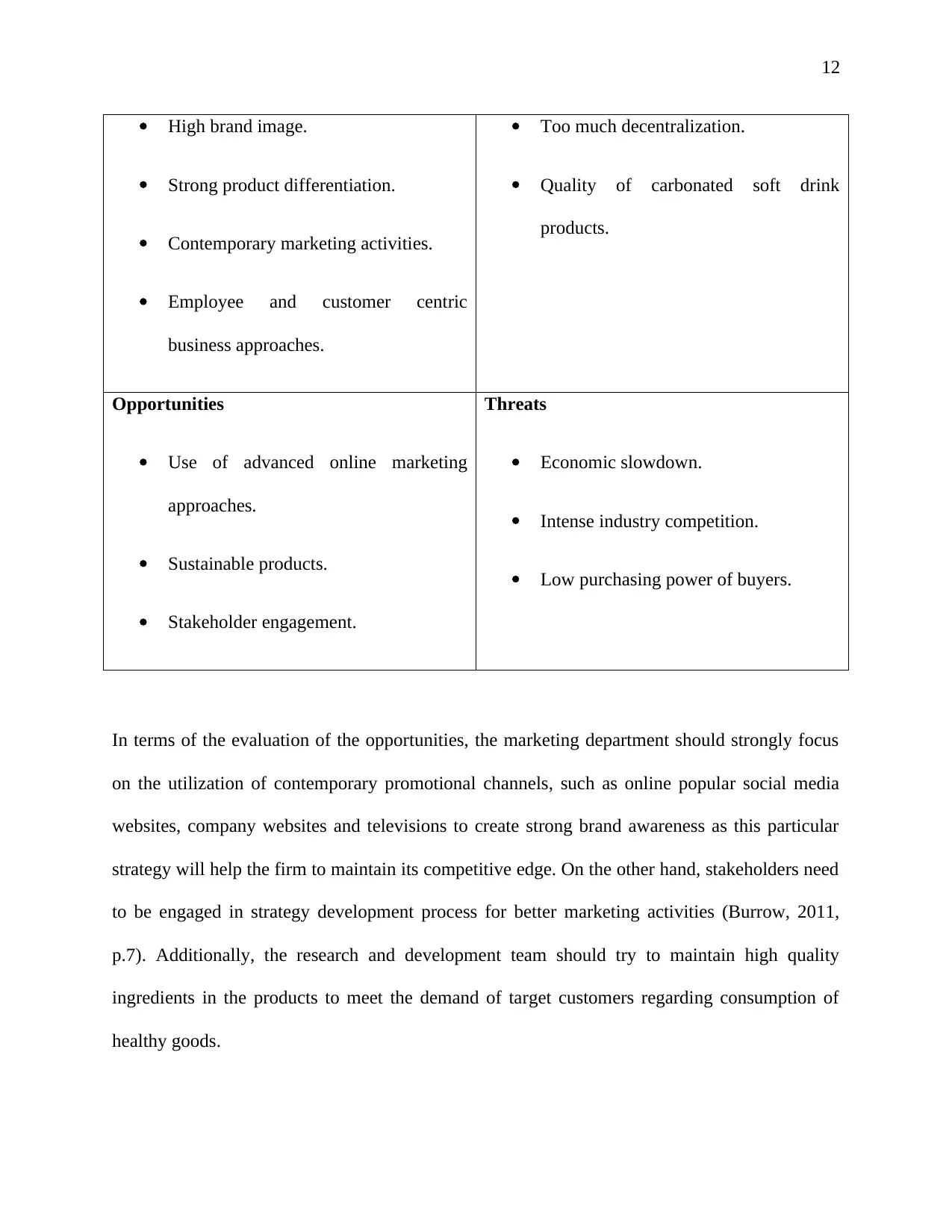
12
High brand image.
Strong product differentiation.
Contemporary marketing activities.
Employee and customer centric
business approaches.
Too much decentralization.
Quality of carbonated soft drink
products.
Opportunities
Use of advanced online marketing
approaches.
Sustainable products.
Stakeholder engagement.
Threats
Economic slowdown.
Intense industry competition.
Low purchasing power of buyers.
In terms of the evaluation of the opportunities, the marketing department should strongly focus
on the utilization of contemporary promotional channels, such as online popular social media
websites, company websites and televisions to create strong brand awareness as this particular
strategy will help the firm to maintain its competitive edge. On the other hand, stakeholders need
to be engaged in strategy development process for better marketing activities (Burrow, 2011,
p.7). Additionally, the research and development team should try to maintain high quality
ingredients in the products to meet the demand of target customers regarding consumption of
healthy goods.
High brand image.
Strong product differentiation.
Contemporary marketing activities.
Employee and customer centric
business approaches.
Too much decentralization.
Quality of carbonated soft drink
products.
Opportunities
Use of advanced online marketing
approaches.
Sustainable products.
Stakeholder engagement.
Threats
Economic slowdown.
Intense industry competition.
Low purchasing power of buyers.
In terms of the evaluation of the opportunities, the marketing department should strongly focus
on the utilization of contemporary promotional channels, such as online popular social media
websites, company websites and televisions to create strong brand awareness as this particular
strategy will help the firm to maintain its competitive edge. On the other hand, stakeholders need
to be engaged in strategy development process for better marketing activities (Burrow, 2011,
p.7). Additionally, the research and development team should try to maintain high quality
ingredients in the products to meet the demand of target customers regarding consumption of
healthy goods.
⊘ This is a preview!⊘
Do you want full access?
Subscribe today to unlock all pages.

Trusted by 1+ million students worldwide
1 out of 15
Related Documents
Your All-in-One AI-Powered Toolkit for Academic Success.
+13062052269
info@desklib.com
Available 24*7 on WhatsApp / Email
![[object Object]](/_next/static/media/star-bottom.7253800d.svg)
Unlock your academic potential
Copyright © 2020–2025 A2Z Services. All Rights Reserved. Developed and managed by ZUCOL.





